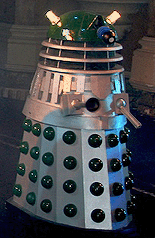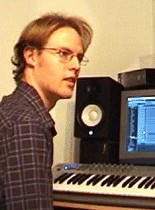| |
 Before
Evil Before
Evil
 The
Beginning The
Beginning
 Adaptation Adaptation
 Influences Influences
 Casting Casting
 Production Production
 The
Score The
Score
 Performance Performance
 Thanks Thanks
|
|
The Evil of the Daleks Stage Show
The Plays Before Evil
Nick Scovell, the man who would go on to write,
direct and star in the stage show of The Evil of the Daleks,
began his Doctor Who stage career in 1996 when he
was offered a slot at the Portsmouth Arts Centre and and opted
to put on a theatrical performance of his recently-written
script entitled Planet of Storms.
The Paul McGann TV Movie had not long been broadcast, and
after obtaining the necessary rights, this Graham Williams-esque
romp was mounted in October 1996 featuring gold aliens called
the Pertinax, and the Terrible Zodin.
One member of the audience in this performance was Rob Thrush,
a local fan, and he was looking for an actor to play The Doctor
in his The Millennium Trap film in 1997. Thrush liked
Scovell's Doctor and asked him to be in the film which went
on to become highly regarded. In due course Thrush joined
the theatre company and they did several plays together.
When another slot came free for a couple of years ahead, Rob
Thrush had suggested that The Web of Fear would make
a good stage show. And so in June 2000 he was able to secure
the rights from both the BBC and writers Mervyn Haisman and
Henry Lincoln to mount a stage production of this lost classic.
Thrush wrote, produced and directed it with Nick Scovell playing
the Doctor.
| |
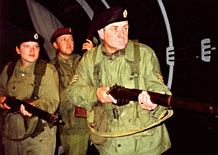 |
| |
Soldiers
patrol in The Web of Fear |
| |
Photo
Courtesy of Rob Thrush |
Nick Scovell picks up the story about where
the play was performed: "The Old Portsmouth Arts Centre
is now sadly closed and bulldozed which was a lovely, lovely
venue. It was a studio theatre, an old converted school. And
the studio space was just the right size. You could only get
ninety people in there. It was a nice stage area and on one
half of the stage there was the railway tunnel and the other
side was the inside of the fortress and laboratory. There was
an empty space in the middle where we did various scenes."
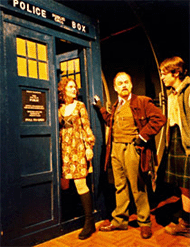 |
|
|
Three of the cast in The Web of Fear |
|
| Photo
Courtesy of Rob Thrush |
|
"Rob’s style of show is quite
different to mine. His were more of direct transference from
the original. A very filmic style. So we cut from one scene
to another very quickly. His style worked terribly well if you’re
doing something that was filmic. We had the first filmed inserts
in that one where it was basically all the stuff that was filmed
on location for [the TV show] was on the screen, and everything
that was in the [TV] studio was live on stage. So on the screen
you had the big battle with the Yetis and us wandering round
outside the station and finding the news seller covered in cobwebs
and stuff like that. It worked very well, Web of Fear
because it's quite a claustrophobic story and The Arts Centre
was a small venue. It had this nice enclosed atmosphere and
the Yetis worked very well as a monster because they were big
hairy beasties and they had huge glowing eyes, and roared! They
really did tower over us. He got some huge actors to play them
and they roasted in these huge costumes."
"I have very clear memories of the rehearsals just being
enormous amounts of fun because it was such a pacey show, all
the scenes were about ninety seconds and we were running around
the one set. There were three or four scenes in the laboratory
I had with Alice who was playing Anne Travers when we were taking
apart the control sphere and they’re very similar scenes
in dialogue and pacing. We could never remember which was the
right order and we’d have to go off and do the same route
round, going offstage to run round to the back to come on again
a different way. It was a nightmare remembering which scene
was in order and Alice and I would be in the blackout asking,
“Which one is it?! It’s not that one? No it’s
that one!” The lights come up and off we go!"
| |
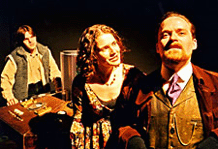 |
| |
Doctor,
Victoria & Jamie in The Web of Fear |
| |
Photo
Courtesy of Rob Thrush |
Doctor Who at this time was very
much deep into 'the Wilderness Years' coming half way between
Paul McGann's only appearance as the Doctor, and the eventual
triumphant return five years later. Publicity for the play highlighted
the fact that it was a lost story to lure fans to the idea that
this might be their only chance to see a forgotten classic.
Such was the draw of this play that when Nick Scovell made enquiries
to the box office after the first rehearsal to see how tickets
were selling, he discovered the play was completely sold out.
An extra performance was booked in for the Saturday matinee
as a result. You can read more on Rob Thrush's website here:
The
Web of Fear Stage Play.
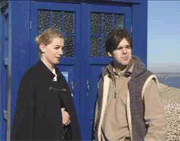 |
|
| Companions
- Fury from the Deep |
|
| Image
Courtesy of Rob Thrush |
|
This success was reflected in the desire
to do a follow up. The same Doctor was booked in 2001 and Rob
Thrush again set about the task of re-creating a lost classic.
In 2002 Fury from the Deep was successfully adapted
and brought to the Theatre Royal between March 27th and 30th
of that year. Once again the play was marketed with the emphasis
on it being a lost story and it worked very well to draw attention.
Like its predecessor, it was a sell-out and you can read more
about the play here: Fury
from the Deep Stage Play.
The Beginnings of Evil
After a gap of a couple of years, it was in
the late summer of 2004, not long after the revived New Series
of Doctor Who had started filming that Nick Scovell
got the impetus to do something Doctor Who related.
His daughters were asking questions about the toy Daleks around
the house and he was very much of the opinion that the lure
of these monsters was not a trick of the childhood memory.
| |
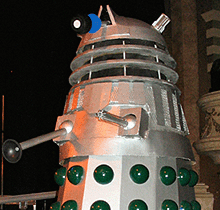 |
| |
An
Dalek on stage in The Evil of the Daleks |
| |
Photo
Courtesy of Daniel Cartwright |
Doubting the likelihood of getting the rights
to do anything official, his initial thoughts turned to a fan
film version of The Evil of the Daleks but whilst running
the idea past Rob Thrush, he suggested to Scovell that is should
go on stage and was worth giving the Theatre Royal a ring. Initial
contact with the BBC was returned the very next day with a phone
call and that rights issue was cleared quickly. Permission then
also had to be sought from the estate of the late Terry Nation.
Whilst awaiting a reply from that corner, written permission
was also requested from, and granted by, the estate of the late
David Whitaker, which is now looked after by one of his female
relatives in Australia. However nine months had passed with
still no word from the estate of Terry Nation. Amazingly, during
this time, the BBC themselves were locked in a rights battle
with Nation's agent, Tim Hancock, who was pushing for more editorial
control over the TV scripts to ensure the Daleks remained true
to their concept. The BBC only secured the use of the Daleks
at the last minute, and Nick Scovell's situation was not dissimilar.
With time running out for booking actors, only after an extremely
persistent amount of telephoning, was he finally able to get
clearance for the play
Adapting the Script for Stage
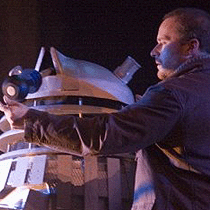 |
|
| Nick Scovell
as The Doctor |
|
| Photo
Courtesy of Simon John |
|
Nick Scovell was then faced with the task of
turning 180 minutes of television in 90 minutes of stage show.
He approached the problem by first making a note of the key
elements of this classic based solely on his memory of it.
A fan coming to see a new version of the story would expect
the iconic scenes which are well known from the surviving
episode two, the rather desperate human struggle, the very
strong characters, and the climactic showdown with the Emperor.
In addition to what the fans would want, he had to weigh up
what someone coming to see it out of curiosity would enjoy,
and what new Doctor Who fans would get from it. The new series
at this point was an enormous success and with Dalek toys
appearing in the shops there was no doubt parents would be
bringing their children during half term. It had to be self-contained,
obviously with no reference to the previous televised story,
and without being tied up in new series continuity. There
were a lot of elements to juggle.
Scovell initially created a wholly faithful stage script,
starting at Heathrow and featuring the Antiques shop, complete
with all the characters, and ending up on Skaro. From here
he then started a lengthy redrafting process, stripping away
any padding and the elements not needed to tell the main story.
Episode one was removed entirely, as it's only function was
setting up the mystery and providing a Dalek cliff-hanger
before the Doctor had seen the face of the enemy. The large
number of locations throughout the story were then addressed,
as the writer explains:
| |
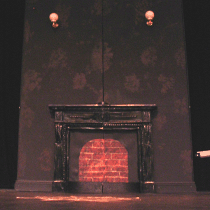 |
| |
The
Fireplace that holds a terrible twist |
| |
Photo
Courtesy of Daniel Cartwright |
"There’s nothing wrong with many
locations but I knew it would be on an open, bare stage, which
is how all my plays are. I don’t like sets at all. They
get on my wick to be honest! I like atmospheres and backgrounds.
They work so much better in the theatre. To go from Heathrow
airport, to an antique shop, to a coffee bar, to a Victorian
mansion, to a planet billions of miles away in the future would
be pushing it a bit. We could not effectively show such a change
in emphasis without having to have some set there. With Evil
you didn’t need it to tell the story."
In restructuring the story, it became clear what had to go.
Jamie's series of tasks were efficiently reduced to just a sword-fight
and the rescue of Victoria and the character of Kemel became
totally redundant. This was no great loss as a good percentage
of the modern audience will only have been familiar with the
audio of the story and therefore are unlikely to feel the loss
of a mute character. Quite aside from the practicalities of
tightening up the narrative, it was not the easiest role to
try to cast, being an amateur company with few willing volunteers
to take on a character with no dialogue. Similarly, the pointless
threat with Windsor Davies' character was jettisoned as it only
served to provide a cliffhanger on TV.
But it was the removal of the multiple locations that became
the key to moulding the whole structure of the play into a self-contained
narrative with it's own unique ending.
The finale provided problems at the script stage due to the
fact that a full-blown Skaro civil war was not possible. Discounting
the idea of filmed inserts as with the previous plays, the compromise
was to reduce the extensive battle to a short but equally terminal
exchange of fire, and combine as much Dalek movement in the
background with a focus on the human characters struggling centre
stage.
Influences
in the Script
Scovell notes how one particular classic Doctor
Who shaped his approach to the new ending. "I think
it was around that time that Ghostlight came out
on DVD and I love Ghostlight, it’s in my top
ten Doctor Who stories of all time. I love it. I
think it’s a work of genius. I thought, if Evil
was something like that, it could it all be set in the house
because you can have that instant atmosphere and I that’s
how I thought of the extra Dalek storyline thread. Some people
said 'Isn’t it going to be a bit of a cop-out?' Well
I don’t think so because I hadn’t done it for
those reasons. I hadn’t thought 'Oh well we haven’t
got a budget therefore it has to be in one place or one room.'
If people think that, then that’s tough, but that’s
not why I did it."
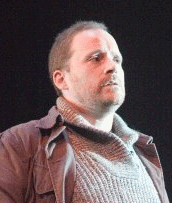 |
|
| Nick Scovell
as The Doctor |
|
| Photo
Courtesy of Simon John |
|
 |
 |
Just like in Ghostlight, in the stage
version of The Evil of the Daleks, the Doctor is
aware that the house he is in is destined to be destroyed
in fire. This brought an interesting angle for those already
familiar with how the story ends, because it was an acknowledgement
that it didn't matter how familiar one might be with the plot,
there was something new on offer.
Moving the showdown from Skaro to the mansion not only brought
a surprise for the audience when the Emperor was revealed
in the fireplace, but it gave the Daleks a different agenda.
Instead of being the all-powerful beings plaguing the galaxy
as they were in the 60s, they took on a more sneaking and
weakened demeanour, having used their time corridor to see
a bleak future for themselves. It was a change which tied
in well with how the Daleks were to be seen in the new series
at the time, where they are always trying to gather strength
and swell their numbers.
In addition to elements being changed and removed, other aspects
of the story were strengthened, particularly with Waterfield
becoming a Reverend. Nick Scovell explains this change:
"This is going to sound strange but I have a penchant
for tortured vicars. I’ve written a lot of plays with
tortured vicars in. I am a man who believes. I have faith
of my own. It’s not desperately strong. I don’t
go to church or anything but I believe, and sometimes I pray.
But I find it a fascinating concept that some people have
so much faith and that they lose it and I’ve known some
people like that."
| |
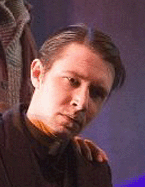 |
| |
Lewis
Bailey as Waterfield |
| |
Photo:
Simon John |
"I like to give characters a real edge
and Maxtible had an edge with his selfishness. Ruth had an edge
because she’s the estranged daughter. But Waterfield didn’t
really have an edge in the original. He was beautifully played
by Lewis Bailey, but he was just like an angry father and that’s
all he was. Making him a Reverend also gave him a reason to
be in the house which isn’t really given in the original
so my reasoning was that Waterfield was someone who had been
chucked out by his church for his scientific beliefs and it
says in the play, “if God exists he must be part of the
fabric of creation and if I could understand what that was woven
from...” So I think his fascination with science drew
him to Maxtible and also got him chucked out of his parish.
He couldn’t let his faith live side by side with his belief
and his wish to really understand through science. That just
gave him an edge, and that could give him some lovely scenes
with the Doctor. The fact that they’re all fathers would
link them as well. You’ve got the devoted father: Waterfield,
the estranged father: the Doctor, and the bastard father: Maxtible.
That to me was very personal, as I’m a very devoted father
to my children and it’s a personal thing I bring with
me to parts and writing. So I was really rather fond of Waterfield."
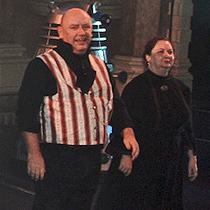 |
|
| Theodore
and Ruth Maxtible |
|
| Photo
Courtesy of Peter Labrow |
|
With this particular tortured Vicar being
faced with an alien invasion in a Victorian setting, the audience
might have wondered if there was a slight homage to the H.G.
Wells novel, War of the Worlds. Scovell comments, "There
might have been a subconscious link, because War of the
Worlds is my favourite novel. It is one of my dreams to
make a film that finally does it justice. But there is so much
material in tortured vicars!"
"I like to debate faith and love even in something which
could be perceived as trivial and lightweight as Doctor
Who. I think that’s an interesting side to the Doctor
as well. That clash of belief and faith. I find that a fascinating
conflict. I believe in the deep rooted, unquestioning goodness
of humanity and the fact that goodness will prevail. But then
I see the terrible things that men can do and the dreadful things
that we can build and make. For me I want to bring that deeper
and more emotional element about the positiveness of humanity.
I love the fact that Russell T Davies has picked up on that
because I believe that is such an essential part of Doctor
Who. And he’s said he’s half human. I know
a lot of fans ignore that but he said it and I think it makes
perfect sense."
| |
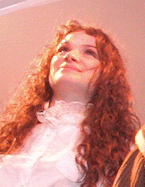 |
| |
Rosie
Grant as Victoria |
| |
Photo:
Peter Labrow |
Nick Scovell also feels that adding the more
adult and thought-provoking scenes was possible thanks to the
quality of the original writer, David Whitaker."I think
he’s the best writer the Daleks ever had. No-one else
understood the Daleks like he did and I think Evil contains
the two best Dalek lines ever: When the Dalek says “There
is only one form of life that matters – Dalek life.”
I think that’s just brilliant. And also the Doctor’s
retort, “I will not be your slave!” because it just
sums up that side of the Doctor perfectly. It’s a very
good, bold line. I think David Whitaker was secretly a very
deep Dalek fan. I’ve also read his script to Curse
of the Daleks and it’s basically Power of the
Daleks several cousins removed. I used some of the dialogue
from that in Evil. There’s a professor examining
a dead Dalek in Curse of the Daleks and he says “The
Daleks only ever recognise success or destruction” and
also the little poem that starts the play, "Remember, remember,
the Dalek December." That’s a nursery rhyme that
they recite in Curse of the Daleks when they remember
the invasion of Earth. That added a slightly dark element to
it. I just love Whitaker’s Dalek dialogue. He wrote them
as characters and their plans are so devious. In both Power
and Evil they’re using humanity against itself
and the Daleks are so good in his hands."
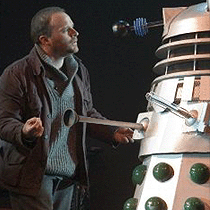 |
|
| Nick Scovell
and a Dalek |
|
| Photo
Courtesy of Simon John |
|
Whitaker's stage script isn't the only place
from which a line was borrowed, as one from Planet of Evil
can be found where Waterfield says to Maxtible,“You and
I are scientists, we purchase our right to experiment at the
cost of total responsibility” and there is even a quote
from Sherlock Holmes in there.
The era of Sherlock Holmes is also the period into which the
play was moved. The TV version of the story was set in the 1860s,
but for practical reasons Scovell brought the play a few decades
forward as he explains, "1860 would be slightly frilly
shirts, the big collars and the big side burns and it would
look a bit like The Good Old Days. I thought if I update
it I can go slightly Edwardian. It was purely practical as it
saved us putting Victoria in a Crinoline. Try to get someone
on and off stage in a Crinoline and you are stuck."
Casting
Although the lead character in the stage play
was not meant to be an impersonation of the second Doctor,
Nick Scovell nevertheless sees similarities between his interpretation
of the Time Lord in this story, and the original.
| |
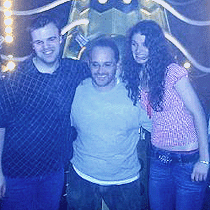 |
| |
The
Doctor, Jamie and Victoria |
| |
Photo
Courtesy of Simon John |
"Patrick Troughton has always been my
favourite Doctor. I think he’s perfect for the part and
I think if he’d never played it I would have played it
exactly as he did - that sort of little worried man. I think
my Doctor is very human and emotional and paternal. I think
that’s what makes your Doctor work, is keeping the paternal
side which is very me as well. When you play the Doctor you
try to play yourself but with a bit more authority and guts.
That’s what makes your Doctor come alive, that caring
side."
"I’d done two shows previously with John Paul McCrohon
as Jamie and I could just hear him say the lines. We’ve
known each other for years and get on very well. I think John
Paul is better than Frazer Hines. He’s a very accomplished
actor. He’s got a lot of charisma, he runs his own theatre
company, he’s got a fantastic singing voice, he’s
got a real belter of a voice for the musicals. He loved playing
Jamie and he’s a big Doctor Who fan as well.
Between the three appearances he put on a few pounds so his
kilt had to be adjusted slightly each time which annoyed him!"
In Web of Fear Victoria had
been played by young actress Nancy Holloway however she was
unavailable for Fury from the Deep so Laura Ford
took up the role. When it came to The Evil of the Daleks,
Holloway was first choice again but she was forced to pull
out. Rob Thrush had used an actress from a local college called
Rosie Grant for a special event, and being talented, attractive
and the right age for the role, she was duly cast as the screaming
Victoria.
| The Doctor |
Nick Scovell |
| Jamie McCrimmon |
John-Paul McCrohon |
| Theodore Maxtible |
James George |
| Rev Waterfield |
Lewis Bailey |
| Victoria Waterfield |
Rosie Grant |
| Ruth Maxtible |
Sally Evans |
| Arthur Terrall |
Phil Cottrill |
| Mollie |
Jane Hartley |
| Kennedy |
Tim Skedge |
| Supreme Dalek operator |
Andrew J. Haslam |
| Dalek Operators |
Liam Bailey
Lorna Bailey
Helen Stoddart
Phil Cottrill |
| Dalek Voices |
Rob Thrush
Tim Skedge |
| |
|
| Daleks Built by |
Ashley Nealfuller |
| Music |
Martin Johnson |
| Stage Manager |
Dave Tozer |
| Stage Crew |
Keith Hartley
Ben Wilkinson |
| Lighting |
Lee Garrett |
| Sound |
Rob Thrush |
| Thanks to |
Nick Briggs
Stuart Currie |
| Special Thanks |
Mike Andrews |
| Assistant Director |
Jon Scovell |
| Front of House |
Wayne Skeens
Tina Bailey |
| Produced by |
Rob Thrush |
| Adapted and Direct by |
Nick Scovell |
|
|
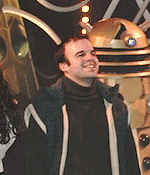
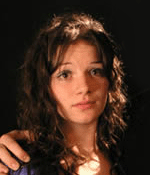
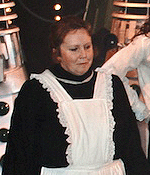

|
The Production and The Daleks
With other projects preventing him attempting
the production in 2005, Scovell knew his next window of opportunity
was in 2006, as he only commits to one big project per year.
With the script finished, countless production meetings had
begun by February. Rehearsals started in September 2006, a
couple of months after David Tennant's tenth Doctor had had
his showdown with the Cult of Skaro in Doomsday.
Rehearsals took place two nights a week for six weeks, followed
by the technical and dress rehearsal in the theatre.
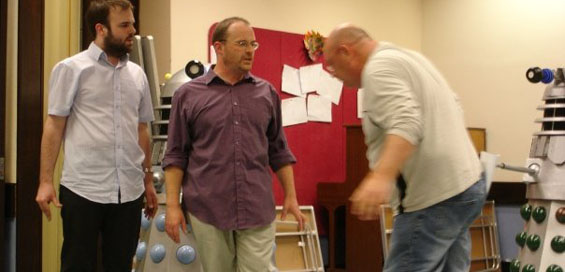 |
| Rehearsing
Evil of the Daleks - Photo Courtesy of Ashley
Nealfuller |
When it came to the Daleks themselves, there
was a slight problem. The play did not have the resources
or the funds to build a set of props. There were none left
over from The Millennium Trap and a variety of possible
sources such as Hyde Fundraisers and This Planet
Earth did not have a large enough set which were all
the same. The props also had to be used for rehearsals and
kept for the duration of the play. The problem was finally
solved by Rob Thrush who suggested the fan film Devious
might have the answer. Sure enough, Ashley Nealfuller came
to the rescue, offering his services and providing a whole
batch of props for use.
The Daleks for The Evil of the Daleks were an interesting
hybrid of the old style and the look which had recently been
introduced in the new series. They fused the tall stature
of the new props with the classic lines of the originals.
They took the flat 'solar panels' from the 60s but added the
configuration of the new series Daleks' large front panel
and eye-cowel.
| |
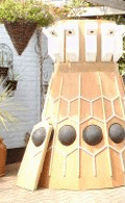 |
| |
Imperial
Construction |
| |
Photo: Ashley Nealfuller |
They were adapted from Ashley Nealfuller's
existing stock of Dalek props. Five Daleks were used in the
stage production of which two had already found fame in the
BBC Comic Relief mini-episode The Curse of Fatal Death.
They also appear in Devious itself and were already
over twelve years old by the time they made their stage debut
in The Evil of the Daleks.
For the majority of the play the Daleks were represented by
two props which were all silver with dark green hemispheres.
Their leader was an all gold Dalek again with green hemispheres.
The use of the colour green is unique to this performance of
The Evil of the Daleks and has never been seen on
television, in film or on stage before.
Ashley Nealfuller also built the Emperor from scratch which
is pictured above right under construction. You can find more
information about his Dalek-building and the rest of the Devious
project here: The
Devious Evil of the Daleks Sub-Site.
When the Doctor administers his Human Factor
to the Daleks, the two regular props become his allies, and
the reveal of the magnificent Emperor prop brought with it two
more Daleks, this time with dark green domes. This tradition
of the dark dome for Daleks associated with the Emperor is a
direct reference to the TV story and has a legacy in the new
series which you can read more about here.
On each performance of the play, the reveal of the Emperor received
a fantastic reaction. Nick Scovell appraises the Emperor: "It’s
perfectly proportioned, solidly built and looked brilliant anyway,
but as soon as you light it it looks fantastic. When they first
stuck it in the surroundings with all the tubes and then we
opened up the fireplace, it was just "wow", with the
lights and the smoke. Every time it opened up it got this huge
round of applause and there was this great sense of excitement.
This sounds really pretentious but when you’re on stage
you can really sense the atmosphere of the audience and the
mood. It took a surge in a similar way to when the Daleks first
came on. I think on one occasion we got a round of applause
when the Daleks came on. The kids were just aghast seeing them
live because they came through these big doors with the smoke.
We managed to get the Emperor looking really, really good. And
the fact that Ashley made the head move and the eye stalk to
light up was great. There was actually someone inside it. Poor
Jon [Andrews] just sat there waiting for God knows how long,
then just wiggled the thing and had to duck as it blew up so
that he didn’t get his head blown off."
| |
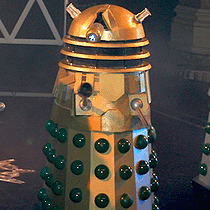 |
| |
The
Gold Dalek |
| |
Photo
Courtesy of Peter Labrow |
Despite the Daleks being a big draw, their
limited movement when acting caused problems in trying to choreograph
the fight at the end, as Scovell explains: "When it came
to rehearsing the finale there was a problem practically with
what to do with the Daleks. Unless you can cut away like you
do on film all you can do with a Dalek is spin it round. We
couldn’t get the fire extinguishers to fire out of their
guns for Evil because there was so many firing simultaneously
it would have been impractical and dangerous. All they could
do is spin round and waggle their guns and flash their lights.
We put that strobe effect on and really concentrated on the
struggle between the human characters who really could do something,
like me getting throttled by Maxtible. It had to happen rather
quickly but once the explosions started people go “wow”
so that’s fine. We spent a lot of money on pyrotechnics!
Yes in the end it worked out very well."
The Score
To compliment the live action, an excellent
and highly atmospheric score was composed by a man plucked
from relative obscurity from the internet and whose career
was launched by the stage play.
For those who heard the theme and incidental music of The
Evil of the Daleks stage play, it might come as something
of a surprise to learn that the composer, by his own admission,
could not read or write music, or play an instrument when
he came to create the score.
Martin Johnson became involved after his version of the Doctor
Who theme entitled "For
a Darkened People" was found on the website WhoMix
by Rob Thrush in September 2005. After discussions by email,
the producers of the play took a chance on using Johnson to
score the whole thing, and he set about researching the story,
initially purchasing a copy of the TV story on audio for inspiration.
The theme tune for the show which can be heard on the above
link on WhoMix, was chosen because the producers didn't want
to use either the original or the new series version. To create
something with the energy of the new series theme, but much
darker in tone, French horns and a church organ were employed
and a cello became the bass line. Adding to the appropriate
Victorian motif of the whole piece, a vocal choir was mixed
and the end result is very fitting for the tone of the whole
play.
| |
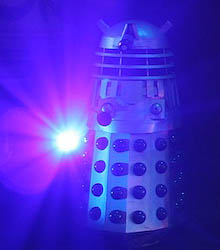 |
| |
Photo
Courtesy of Peter Labrow |
Often being struck with inspiration whilst
out cycling, Johnson would literally hum the melodies which
came to him into a Dictaphone, and then record them digitally
into the computer later.
The first elements dealt with were the Daleks, and after creating
the sinister theme for them, he adapted it into a more playful
waltz-like variation for the human Daleks. He then set about
devising the lighter melody for the Waterfields and the much
darker theme for Maxtible. The latter is in fact darker than
than the Daleks' own theme, in order to reflect just how evil
this human character becomes in his greedy and manipulative
quest.
Having met Nicholas Briggs during the read-through for The
Evil of the Daleks, the conversation turned to the officially
licensed Doctor Who audios made by Big Finish and
how Johnson would like to work for them. It was a few months
before the read-through for the stage sequel The Daleks
Master Plan, when Johnson was asked to audition for Big
Finish. He sent his audition just before production week on
the play, and, with chats continuing during the run, it resulted
in him working on the official Doctor Who audios.
And so, following in the footsteps of Nick Scovell who appeared
with Colin Baker in Whispers of Terror and with Paul
McGann in The Stones of Venice, Martin Johnson was
welcomed into the Big Finish fold, working on the May 2008
release Assassin in the Limelight, then The Doomwood
Curse.
Performance
The play ran at the New Theatre Royal, Portsmouth
between 25th and 28th October 2006 during which time more
than 3000 came to see the play and reviews were glowing. It
was the first time for thirty years that a company at that
theatre had played to a sell-out house every single night,
so the draw of the play cannot be under-stated.
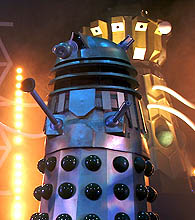 |
|
| Photo
Courtesy of Peter Labrow |
|
Proceeds went towards the restoration of the
theatre and and £15,000 was raised. In addition, £550
was raised for Children in Need.
The play opens with the Dalek nursery rhyme taken from Curse
of the Daleks, recited by all the main characters. The
first five minutes of the play created a new scenario with
the TARDIS being drawn off course and landing in a Victorian
mansion. This quickly and efficiently replaced the whole of
episode one and removed the need for any unnecessary tie-in
to the TV shows arc-story in which the TARDIS had been stolen
in the previous adventure. The Doctor finds a receipt for
a large amount of raw material suggesting some massive engineering
feat has been attempted in the house...
Thereafter we meet Waterfield and Maxtible and during a very
faithful rendition of episodes two and three, we learn of
their attempts to travel in time, plus the influence of the
Daleks.
A nice touch to the stage direction was in having two Dalek
casings always present at the back of the set, so even during
non-Dalek scenes, the monsters cast a metaphorical shadow
over the play all times, and acted as a constant reminder
of their evil influence.
Maxtible's greedy and callous nature begins to be revealed
and we learn that the Daleks are looking for the human factor
in Jamie. His test is to rescue Victoria from the Daleks and
the Doctor anaylses his emotions.
The cliff hanger of the first half ends with the Daleks about
to exterminate Jamie and Victoria!
But as the second half begins, the Daleks spin round and in
fact exterminate their human collaborator. The human drama
unfolds as the Reverend Waterfield grapples with his faith
and tries to reconcile the horrible things he is seeing with
his desire to get closer to God.
The Doctor injects it into two Daleks who develop child-like
behaviour and want to make friends. But these new creations
are de-activated and the Doctor realises that there is a higher
power at work.
As more Daleks enter the room, the large fireplace which has
dominated the play splits to reveal the Emperor Dalek, bathed
in light and shrouded in smoke.
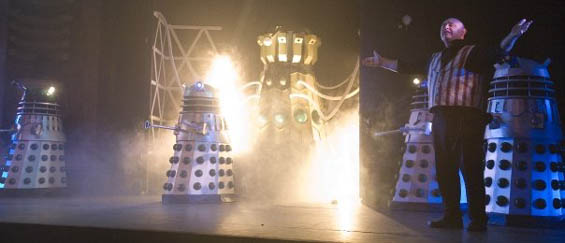 |
| The
explosive finale of Evil of the Daleks - Photo
Courtesy of Simon John |
The Doctor realises the Daleks have projected
their time corridor eons into the future to a time where there
are almost no Daleks. The Doctor says that the two Daleks
he has made human will start to question and they will cause
other Daleks to question. But the Emperor says that the Doctor
has in fact shown them the Dalek factor and the human race
will be reborn as Daleks. Maxtible becomes the first to be
treated.
The Doctor is told to spread the Dalek Factor through the
entire history of Earth and will help through his own free
will... when he becomes the next Dalek human! The treatment
beam shines down and the Doctor is being converted...
But then one of the test Daleks sees what is happening to
his new friend, the Doctor. Jamie shoots the gold Dalek and
whilst chaos breaks out the Emperor shouts "Do not fight
in here!" as Maxtible attacks the Doctor. Waterfield
intervenes and explosions erupt as Daleks spin and attack
each other, and Waterfield dies.
The Doctor reflects on the fact that they have saved the future
and with Victoria, they leave.
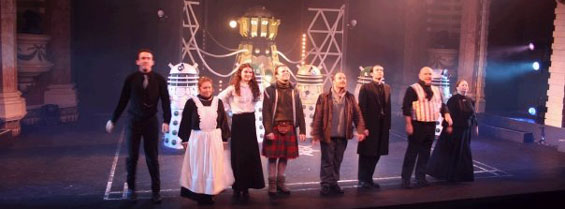 |
| The
end of The Evil of the Daleks - Photo Courtesy
of Simon John |
Thanks
I wish to express my sincerest thanks to these
people who not only created the stage show, but have also
been kind, enthusiastic and helpful in putting this website
together. They are:
| Nick Scovell : |
|
Writer, Director and Doctor
My sincere thanks for agreeing to an interview and providing
this website with the majority of its content about the
stage play. |
|
|
|
Rob Thrush : |
|
Producer, Set-Designer,
Sound Effects, and Dalek voices
Bedlam
Theatre Company Website
I am extremely grateful for the inheritance of the domain
as a springboard for the site. |
| |
|
|
Ashley Nealfuller : |
|
Dalek Supplier and Emperor Builder
The
Devious Website
The
Evil of the Daleks Sub-Site
Thanks for photos, information and support. |
| |
|
|
Martin Johnson : |
|
Composer
EverybodyelsE
Website
Thanks for facts, additional information and support. |
| |
|
|
I would also like to thank Peter Labrow of
Dalek
Links, Simon John, Daniel Cartwright and Anni Ruecroft
for their permission to use their photographs throughout the
site, without with it would be a much more boring place!
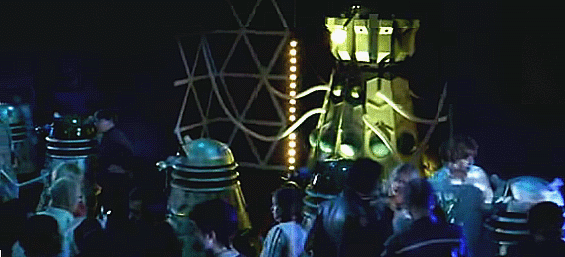 |
| The
audience get to meet the stars of The Evil of the
Daleks after the play |
| This
image is courtesy of Anni Ruecroft and is available as
video here: YouTube
Clip |
| |
|























